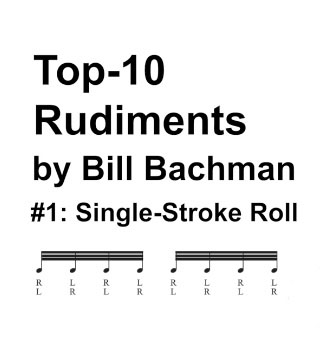Top-10 Rudiments, Part 1: Single-Stroke Roll


Playing rudiments properly is a challenge because they are so physically demanding—not so much in terms of muscular strength, but in terms of finesse and dexterity. Many repetitions are necessary in order to train your muscles and to develop the coordination required to play them effortlessly. But all of that practice will be time well spent, since once you develop the proper muscle memory you’ll never have to think about the mechanics of the rudiment again.
The first rudiment we’re going to look at is the single stroke free strokes (also known as full strokes or legato strokes), which means that the hands are holding the sticks loosely and are “dribbling” them on the drumhead. Resist any temptation to hold the sticks tightly or to stop the stick at the bottom of the stroke. Allow the stick to rebound back to the “up” position immediately after striking the head. The technique needed to play this rudiment is pretty much the same at any speed, though different wrist-to-finger ratios will be required depending on the rebound (or lack thereof) of the playing surface. It’s common for many players to favor the fingers at high speeds, but keep in mind that finger technique won’t work very well on a relatively mushy surface like a floor tom head.

This article is culled from Bill Bachman’s popular Stick Technique book, which is designed to help players develop hands that are loose, stress free, and ready to play anything that comes to mind. The book is for everyone who plays with sticks, regardless of whether you’re focusing primarily on drumset, orchestral percussion, or the rudimental style of drumming. Divided into three main sections – Technique, Top-Ten Rudiments, and Chops Builders – Stick Technique is designed to get you playing essential techniques correctly and as quickly as possible. Also includes a bonus section two-hand coordination and independence. Advertisement

